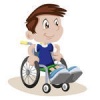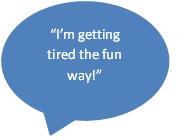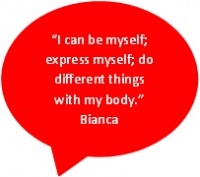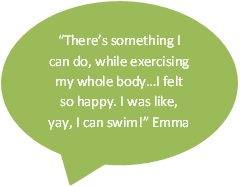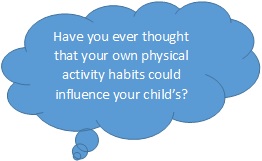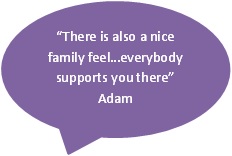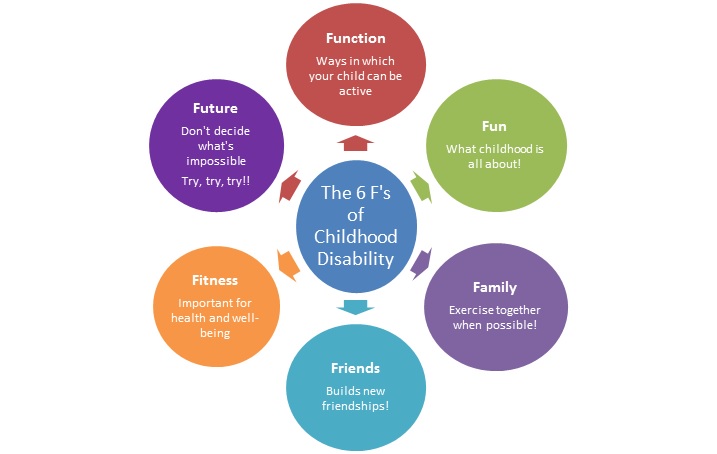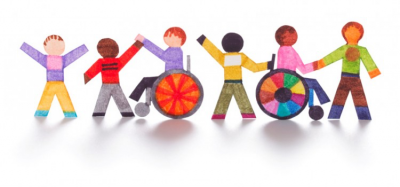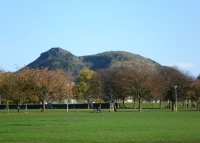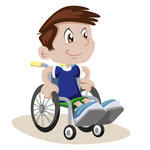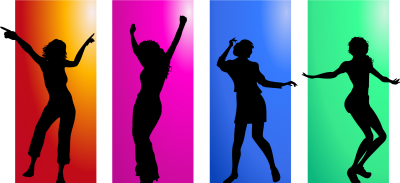The aim of this online resource is to provide parents of children with physical disabilities with information regarding the importance of physical activity in their child’s lives. It offers a guide to the sporting and recreational opportunities available for children in Edinburgh and the Lothian area. The following page will talk about the health benefits of physical activity. It also looks at what may prevent your child from being physically active, and what support and opportunities there are for you and your child. It hopes to cover all the key information that parents would require, so that their children can take part in the variety of physical activity opportunities that is available to them. Throughout this resource, your thoughtful guide Theo will share some of his thoughts and encourage you to start thinking about certain topics.
![]()
![]()
![]()
Your child should aim to take part in at least one hour of medium to hard intensity physical activity every day.[1] These are types of activities which may make your child work up a sweat. Taking part in these activities will speed up your child’s heart rate and will warm up their body for further activities. They will also leave your child feeling a little out of breath; but don’t worry, it is completely normal. An example of such activities are laid out below.
These guidelines are set out for children in general. If your child has a disability or medical condition, activities and exercises should be adapted according to what they can do.
If you want to more know about the type of activities available and what level of intensity they should be performed at, click [2] If you still feel uncertain about the amount and types of exercises/activities that are best suited for your child’s need, contact your local GP or physiotherapist for more specific advice.
![]()
![]()
![]()
If you are still not convinced that taking part in physical activity is crucial for your child’s health an wellbeing, here are a few more reasons that will hopefully win you over:
Did you know that manual wheelchair users often feel pain around their shoulders? This is because shoulders are naturally made for moving around rather than for constantly lifting and pushing lots of weight![13] The day-to-day life of a person who uses a manual wheelchair often involves a lot of pushing and lifting; from pushing themselves around all day to lifting themselves into and out of their wheelchair. This means that if your child injures their shoulder, it may really limit the amount of things they can normally do for themselves.[13][14]
How can they injure their shoulder? The same way everyone else can! Many injuries can happen from carrying out a shoulder movement for a specific task that is difficult to complete. For example, lifting a very heavy object over your head. You can also hurt your shoulder by repeatedly performing a normal movement so often that your joint begins to wear down.[13] Activities like pushing your wheelchair a long distance or transferring in and out of your wheelchair many times throughout the day. This is called an overuse injury, because your shoulder becomes overused without having enough time to rest and heal.[13][14]
Now you may be thinking, “well if my child may hurt their shoulder from overuse, does that mean they shouldn’t play any sports which require a lot of shoulder movement?” This is definitely a valid question and there is no definitive answer. While it is very important to pay close attention to how your child’s joints are coping with the stress of physical activity, exercises to strengthen muscles around these joints can also help protect them. When managed correctly, an active wheelchair user is less likely to have shoulder pain than a sedentary one. In fact, a sedentary wheelchair user may develop shoulder pain up to 4 years sooner than a wheelchair athlete![13]
Getting exercise through sports is a great way to help strengthen your child’s muscles. Making sure their muscles and joints are strong means they will have the best chance at living independently, and goes a long way to improving their overall wellbeing![13][14]
What are some other common injuries and young wheelchair athlete may encounter? Here is a list of a few things to watch out for, with some helpful tips on how to avoid them![15]
“Have a think about whether your child is prone to any of these injuries. Can you think of any other injuries not listed here? How prepared are you to prevent these from happening?”
Now let’s take a look at some of the more serious health risks linked to inactivity.
Now that you are more aware of how important physical activity is and how not being active enough can affect your health, take a moment to think about where you are in terms of your own physical activity levels and where you want to be.
For parents and grandparents who want to spend time being physically active with their children and grandchildren, here is what’s recommended for you:
By now you are well aware of how important it is for everyone to take part in physical activity, but we all know it’s not always that simple when your child has additional support needs. You may find a number of things get in the way when you are trying to enable your child to take part in activities.
“Something to take note of…As a parent you may presume your child is meeting their daily physical activity requirements during play time in pre-school. However, much of the free play in pre-schools involves seated activities, so make sure you include some physical activity after school time as well.”
Facilitators: what can make it easier
Do you feel you can identify with some of these barriers? Here are some ways in which you can motivate and help enable your child to engage in sports and other activities.
Personal Facilitators
The health benefits of physical activity may not be motivating factor for young children to exercise; however, finding an activity that provides fun and enjoyment is very important in facilitating and maintaining a physically active behaviour.[20]
- The sensation of speed is something that children have reported as an enjoyable feeling, thus proving to be an internal motivator. Therefore providing your child the opportunity to experience this feeling, be it through running, swimming, dancing, cycling, rolling on a ball or bouncing on a trampoline can be a key start to introducing a physically active behaviour in your child.[24]
- The feeling of being physically capable, along with the sense of achieving mastery in their chosen activity is crucial to improving self-efficacy; a important factor in adopting a physically active behaviour.[17]
- Finding activities that your child feels they can perform independently and well provides them with a sense of pride and accomplishment, further motivating them to be physically active.
- Since children also enjoy “showing off” every now and again, playing games with a competitive spirit can often be a good way to get them involved in physical activity.
- Desirable changes in body image along with improvements in physical function, such as becoming stronger, fitter and more agile can be a big motivator for your child. It can improve their ability to move around and thus become a vital motivating factor as it allows them to become more independent, gives them a sense of ownership over their own body and may also reduce the need for occupational therapy and physiotherapy.[17]
Social Facilitators
- Studies haven shown that children (aged 4-7) of physically active mothers are twice as likely to take part in physical activity than children with inactive mothers. The are also 3.5 times more likely to engage in physical activity if they have active fathers. Those with two active parents are almost 6 times more likely to be physically active than children of inactive parents.[25] As a parent, you are the most influential role model to your child. That’s why your own behaviours and the value you place on physical activity will directly effect the level of your child’s participation in sports and activities.[26]
- If you have managed to introduce a physically active lifestyle from a young age – that’s great! However, maintaining this lifestyle can be challenging as your child grows older. Parental support is also thought to be a key factor in maintaining physically active habits.[27] Thus, the importance you place on your child’s physical activity levels, along with the encouragement and support you provide is vital in facilitating your child to maintain an active behaviour. This involves your willingness and ability to provide transport to practices and competitions, and showing support and appreciating their achievements in order to aid participation.[17]
- As a parent, you are also in charge your child’s daily schedule. Why not reduce screen time during the day and encourage your child to go outside and play? Factor in the time taken to go to the park or a class to include physical as a daily requirement.
- Habits of friends and siblings can also impact your child’s decision to take part in activities. Children enjoy belonging to something or someone; taking part in activities with family and friends can give them a feeling of togetherness and of being noticed and accepted as part of a group.[24] It also gives them the opportunity to meet others with similar abilities and most importantly to be seen as more than their disability!
What’s Key To Remember?
“To sum it up, keeping these six Fs of childhood disability in your mind will help you remember what’s most important to them and the key motivators to encouraging your child to being physically active!” [28]
Funding
As mentioned, cost can be big barrier to taking part in sport; therefore, this section will guide you to organisations, foundations and trusts in Scotland that can financially support your family and enable your child to take part in the sports and activities of their choice.
General Funding
[email protected]
Telephone: 0844 414 8288
The Stanley Morrison Trust
The Stanley Morrison Trust supports charities and community groups by sponsoring events that encourage young people to become more active. No exclusion criteria was provided.
Telephone: 0141 578 2252
[email protected]
Equipment Funding
Holiday Grants
Are you planning a holiday? If you want to learn about funding for respite holidays and applying for family holiday grants then head over to
Opportunities In The Lothians And Forth Valley
As a parent, regardless of whether your child has a physical disability, you will often worry about how to provide the best opportunities for your child. By now, you should know that physical activity plays a very important part in every person’s life.
Take a moment to think about how active you are as a family.
Every family is different. Some families lead very active lifestyles, but find it hard to include their child when taking part in certain activities. Others may be a lot less active and then the challenge becomes even greater.
This section will explore a number of different sports and activities. It will also direct you to the opportunities out there for your child and family to become more physically active.
Indoor Sports
Swimming
Have you ever thought about swimming for your child, but were unsure whether swimming pools near you cater to the additional support needs your child may have?Edinburgh Leisure offers Disability Swim in three locations across Edinburgh. The information for these is as follows:
Dalry Swim Centre: Wednesdays from 10:30am – 11:30am
Dumbrae Leisure Centre: Mondays from 11:00am – 12:00pm
Warrender Swim Centre: Mondays from 10:30am – 11:15am
Prices: Standard £5, Discount card £3.75, Junior and Disability Discount card £2.50.
Go to their [email protected]).
Wheelchair Basketball
Does your child prefer a team-based sport perhaps? Why not give wheelchair basketball a try? Playing this fully inclusive, fast-paced game is a great way for your child to stay physically active, build their self-esteem and make new friends.
Hear what parents and kids have to say about wheelchair basketball:
If your child wants to shoot hoops, Lothian Phoenix Wheelchair Basketball Club (LPWBC) offers weekly training for children at the following site in West Lothian:
Armadale Academy: Thursdays from 7:00pm – 7:45pm
To get in touch with LPWBC and learn more about the rules of wheelchair basketball, visit their
Judo
How about something more rough and tumble? Practicing judo can help build physical and mental toughness and improve self-confidence. If your child is interested in judo, Jidel Judo Club (JJC) run training sessions specifically for individuals living with disabilities at the following locations:
Craigswood Sports Centre (Livingston): Mondays from 6:45pm – 7:30pm
Napier University (EN)GAGE Sports Centre (Edinburgh): Tuesdays from 7:00pm – 7:45pm
To book a taster session and learn more about the classes at JJC, head over to their Badminton
Have you ever thought about badminton for your child but were unsure where to start? Playing in the Lothian Disability Badminton Club (LDBC) is a great way for your child to develop better hand-eye coordination and meet new people in a friendly environment. The LDBC is open to individuals of all ages and abilities. Sessions are held at following two sites:
Musselburgh Sports Centre: Tuesdays from 6:00pm – 7:00pm (for beginners) and 7:00pm – 9:00pm (for players with disabilities)
Bathgate Academy: Wednesdays from 6:00pm – 8:00pm (for players with disabilities)
Prices: Free first session, then £4 per session or £25 for an annual membership.
Listen to a mother talk about how the LBDC has changed her son’s life:
For more information, visit their
Tennis
Does your child look up to Andy Murray and dream of playing tennis? Edinburgh Leisure and Winning Wheels Wheelchair Tennis Club (WWWTC) have partnered up to make it a reality. Tennis classes for children using wheelchairs and those with additional support needs are held at Craiglockhart Tennis Centre during school term times. The information for Junior sessions (aged 16 and under) and Adult sessions (aged 16 and over) are as follows:
Sundays from 3:30pm – 4:30pm (for children with additional support needs)
Sundays from 4:30pm – 5:30pm (for children using wheelchairs)
Sundays from 5:30pm – 7:00pm (for adults using wheelchairs)
Mondays from 11:00am – 12:00pm (for adults with additional support needs)
Prices: £4.40 per session for Juniors, £4.40 per Additional Support Needs session for Adults, £5 per Wheelchair session for Adults.
Call 0131 443 0101 or email Anna Myatt ([email protected]) to arrange a FREE taster session.
If you want to know more about WWWTC, go to their
If you stay in Forth Valley, Stirling Tennis Club has sessions on Saturday afternoons that are open to all school-aged children with a disability. For further information, please contact Hannah Pickford by email ([email protected]) or telephone (07986221506).
Multisports
What if your child wants a mixture of different sports? What happens then? Well, No Limits Sports Club is a club for children and young adults living with a disability. The only issue is that it is not well known to all of you out there. It is based at the Linlithgow Leisure Centre and includes sports such as boccia, badminton, carpet bowls, table tennis, archery, football. To make it sound even better, the attendance fee for your child is £2 and siblings go for £1.50. Why not make it a family outing?
If you don’t believe it, head to this [email protected]) or by telephone (01786 466486).
Central Wheelchair Multisports Club also offers Wheelchair Basketball and Wheelchair Tennis for young people. Sessions are held at Stirling University on Mondays from 4:00pm – 6:00pm. If you are interested in joining the action, please contact Mitchell Graham by email ([email protected]).
Outdoor Activities
Walking
Who says you have to run a marathon or kick a football to be active? Did you know that walking is a great way to enjoy fresh air and beautiful scenery with your family? Walking as a family is not always easy if a family member is using a wheelchair; but, this is not to say that it is impossible. With the wonderful and accessible walking routes Edinburgh and the surrounding Lothian area has to offer, you are bound to find somewhere you can enjoy walking as a family. Here are just some of the places you and your family can take a lovely stroll:
Britannia Walk
Do you live near or frequently visit Ocean Terminal Shopping Centre in Leith? If so, then why not enjoy a nice walk along the water where the Britannia is docked. It’s less than a mile, mostly flat and ideal for buggies and wheelchairs. Perhaps after a day of shopping in Ocean Terminal, you could head down there for the fresh air and stunning view. For those of you who still don’t know where it is, pop EH6 6JJ into maps on your phone or your GPS and it should lead you next to the blue car park of Ocean Terminal Shopping Centre.
The Meadows
This is another scenic walking route that you and your family can enjoy in Edinburgh. It’s mostly flat and quite short, but it’s accessible to people using wheelchairs. So, if you are willing to get out and take part in some exercise, head over to the Meadows off Melville Drive on the A700 with your entire family.
The Water of Leith – Walkway
This wonderful walkway passes through many areas in Edinburgh such as Stockbridge, Royal Botanic Gardens, and Scottish Gallery of Modern Art. It’s ideal for family strolls as it’s a great getaway from the hustle and bustle of city life. This route is suitable for cycling and can be accessed in part by wheelchairs and even by horseback! If you are keen on planning a trip with your family to explore this route, visit North Berwick – Beach Wheelchairs
Equipment Funding
Holiday Grants
Are you planning a holiday? If you want to learn about funding for respite holidays and applying for family holiday grants then head over to
Opportunities In The Lothians And Forth Valley
As a parent, regardless of whether your child has a physical disability, you will often worry about how to provide the best opportunities for your child. By now, you should know that physical activity plays a very important part in every person’s life.
Take a moment to think about how active you are as a family.
Every family is different. Some families lead very active lifestyles, but find it hard to include their child when taking part in certain activities. Others may be a lot less active and then the challenge becomes even greater.
This section will explore a number of different sports and activities. It will also direct you to the opportunities out there for your child and family to become more physically active.
Indoor Sports
Swimming
Have you ever thought about swimming for your child, but were unsure whether swimming pools near you cater to the additional support needs your child may have?Edinburgh Leisure offers Disability Swim in three locations across Edinburgh. The information for these is as follows:
Dalry Swim Centre: Wednesdays from 10:30am – 11:30am
Dumbrae Leisure Centre: Mondays from 11:00am – 12:00pm
Warrender Swim Centre: Mondays from 10:30am – 11:15am
Prices: Standard £5, Discount card £3.75, Junior and Disability Discount card £2.50.
Go to their [email protected]).
Wheelchair Basketball
Does your child prefer a team-based sport perhaps? Why not give wheelchair basketball a try? Playing this fully inclusive, fast-paced game is a great way for your child to stay physically active, build their self-esteem and make new friends.
Hear what parents and kids have to say about wheelchair basketball:
If your child wants to shoot hoops, Lothian Phoenix Wheelchair Basketball Club (LPWBC) offers weekly training for children at the following site in West Lothian:
Armadale Academy: Thursdays from 7:00pm – 7:45pm
To get in touch with LPWBC and learn more about the rules of wheelchair basketball, visit their
Judo
How about something more rough and tumble? Practicing judo can help build physical and mental toughness and improve self-confidence. If your child is interested in judo, Jidel Judo Club (JJC) run training sessions specifically for individuals living with disabilities at the following locations:
Craigswood Sports Centre (Livingston): Mondays from 6:45pm – 7:30pm
Napier University (EN)GAGE Sports Centre (Edinburgh): Tuesdays from 7:00pm – 7:45pm
To book a taster session and learn more about the classes at JJC, head over to their Badminton
Bathgate Academy: Wednesdays from 6:00pm – 8:00pm (for players with disabilities)
Sundays from 4:30pm – 5:30pm (for children using wheelchairs)
Sundays from 5:30pm – 7:00pm (for adults using wheelchairs)
Mondays from 11:00am – 12:00pm (for adults with additional support needs)
“If you thought it was impossible to push a wheelchair on the sand, think again.” Beach Wheelchairs is a Scottish Charity that makes it possible. They believe that everyone has the right to enjoy the beautiful beaches Scotland has to offer. This amazing charity provides beach wheelchairs and walkers for children and adults which can be collected from the Beach Hut at North Berwick Harbour in East Lothian. Not only that, if you want to, you can loan a beach wheelchair for free! If you’re wondering how to book this fantastic opportunity, all you have to do is keep reading.
How to book: Call 03001112112 to discuss the available equipment and book a session which suits you. Sessions can be held in the morning, afternoon or evening, every day of the week. For more information click Royal Botanic Gardens Edinburgh (RBGE)
Did you know that the RBGE has wonderful gardens and glasshouses, an art gallery, a visitor centre and some restaurants? The gardens are largely accessible to wheelchair users and the all the buildings have level or ramped ground floor access. Also, any steep paths which are not wheelchair accessible are signposted and garden staff can advise you on the glasshouses that are not accessible. This will prevent any disappointments! If you visit their Edinburgh Royal Mile Wheelchair Accessible Walking Tour
If you have family or friends visiting from other parts of the world, perhaps a walking tour of Edinburgh is just what you are looking for. Due to the prices, this may not be an option for everyone; but it’s definitely worth knowing about. The tours run 7 days a week and an 8-hour tour costs £360 for 2 people or £420 for a group of 4. The highlights of the tour include the Royal Mile, Princes Street and Holyrood Palace to name a few. The walking tour also takes time out for some lunch. If you are interested in finding out more or booking a tour, click Cycling
Learning to ride a bike is part of a normal childhood; but, as you may already know, for some children this is not always possible. No child should have to be told that they can never go for a bike ride; and thankfully, with the development of adapted bikes it should no longer be an issue. Yet as a parent, you are probably wondering whether you can even afford one of these specially designed bikes. Well, you will be happy to hear that there’s a cycling hub in Edinburgh where bikes can be used daily/weekly. Not only will this recent project provide more opportunities for you and your family, but it will also support the growth and learning of your child. FABB/Blazing Saddles is a mobile all-ability cycling initiative. They provide cycling for disabled people by lending adaptive bikes and equipment through 12 local hubs. Luckily, there is a cycling hub right here in Edinburgh! The aim of this fantastic initiative is to challenge barriers and improve access for disabled individuals, so that they can take part in social, leisure and educational activities of their choice. Cycling may, be something your child would like to participate in and Blazing Saddles makes it much more possible for them. In the Lothian area, there’s an all-ability cycling hub based in Bangholm Outdoor Education Centre. Currently, this bike centre is approaching winter break and will be closed from 30th November, 2016; however, activities will resume on 20th February, 2017 as follows: Tuesdays from 10:00am – 12:00pm (for pre booked groups) They have a range of adaptive bikes, trikes, side by sides, hand-cycles, wheelchair transporters and standard bikes of different sizes. All sessions are supported by trained staff and volunteers to ensure that everyone can enjoy cycling regardless of their age, backgrounds, experience or ability. All sessions are FREE and new riders should get in touch to arrange a first visit for a trial of the bikes.
“What’s your excuse?” This will be a great chance for you and your family to enjoy cycling together. They also has a Facebook page and Twitter account so that you can follow all the updates. Have a look at the attached flyer below for contact details and more information about this amazing opportunity.
Enjoy the ride!
You can download their flyer here: Edinburgh All-Ability Bike Centre Flyer
How to find it: Bangholm Outdoor Education Centre, 28 Craighall Gardens, Edinburgh, EH6 4RJ
If you have a burning desire to enrol your child in a riding school then who is to say it’s not possible? Or, has your child ever expressed their wish to ride a horse, but you think it’s impossible? Riding for the Disabled Association (RDA), is a national charity set up to provide therapy, achievement and most importantly, fun. Dedicated physiotherapists, staff members and volunteers work regularly with horses and ponies to fundamentally improve the minds of 28,000 people across the UK. Luckily, the RDA has a few sites here in the Lothian area. Unfortunately, due to the costs of horses and the growing demand, most place have waiting lists.
Did you know that riding creates friendships, helps muscle coordination, builds self confidence and is great fun?
Here is a list of the different locations and their websites around Edinburgh: Drum (Gilmerton), Muirfield (North Berwick), Ravelrig (Balerno), Thornton Rose RDA (Rosewell), West Lothian
Now for some more information on the riding sites for your child:
Muirfield Riding Therapy (MRT) is a riding school that operates 7 sessions per week. It is open to children, teens and young adults, for FREE; however, you do have to apply before you show up. All you have to do now is go to MRT’s website and complete the form. In some instances, you may even get a referral from your GP.
Check out what MRT school has to offer and fall in love instantly: If MRT seems far away, Thornton Rose is another option for you. This riding group provides opportunities for people of all ages and disabilities to enjoy a safe, stimulating and therapeutic activity. Although Thornton Rose is the only group based in Midlothian, it is open to everyone in the Lothian area. Interestingly, not all participants are riders; some members come and care for the horses while others do chores around the stables. Sessions are FREE and usually last about 30-35 minutes. During this time, parents and carers are asked to stay in the yard, but are also welcome to ride with their child for the first few weeks to settle them in. To further entice you, there is a caravan in the yard with tea and coffee! This all sounds perfect right? Unfortunately, the waiting list can be quite long. Participants also need to be matched to particular horses and the amount of time this may take is unknown. For some this wait is short, but for others, it may be several years.
Golf may not appeal to most of you, but for those of you who are interested, there’s an opportunity for you and your family to enjoy a round of golf at the 12-Hole Hermitage Family Golf Course here in Edinburgh. Known as the first course of its type in the UK, it enables people living with disabilities to enjoy a game of golf at their own pace. This fantastic golf course is located in Braid Hills Drive and caters for the additional support needs your child may have. If that hasn’t persuaded you, a resident PGA golf professional offers private and group sessions. Golf camps are also held all year round and there’s an open-to-all coffee house on site. For more information don’t hesitate to visit their Race Running & Athletics
Has your child ever wanted to zoom around the track like the superhero Flash? Race running might just be the sport for them. A recognized international disability sport, race running involves running around the track with the support of a specialised bike. Race Running is a fantastic way for your child to improve their overall fitness, strength and well-being.
Although there are currently no active Race Running clubs within the Lothian area, there may opportunities in the near future. In the meantime, your child can get fitted for a running bike at all-ability cycling hub based in Bangholm Outdoor Education Centre and whiz across flat walking paths.
For further information on getting fitted for and renting running bikes, contact David Glover at the All Abilities Bike Club by telephone (07500 069357) or email ([email protected]).
Check out the following video to get a better idea of what it’s all about:
If you live in Forth Valley, the Forth Valley Flyers Club is an athletics club for individuals (aged 10 and over) with a physical, sensory or learning disabilities from Falkirk, Stirling and Clackmannanshire. They provide sessions for children, young people and adults involving everything from walking / running 40m to 1500m, javelin and shot putt to bean bag throw, long jump and standing long jump. The also have a Race Running Squad for athletes with restricted mobility. The bikes are provided and can be used by individuals (aged 3-4 and over). The sessions are held at Grangemouth Athletics Stadium on the following days:
Fridays: 5:30pm – 6:45pm (Athletics) Prices: £2 per week, £10 membership per year
For further information contact Ann Finlayson by email ([email protected]).
If you thought things could not get any more fun, they just have! The Yard is a purpose built indoor and outdoor adventure playground for children and young people living with disabilities. It lies in the heart of Edinburgh and, quite simply could not cater for people with additional support needs any better than it already does. This is a place for your whole family; it will give you and your children the chance to explore your surroundings and interact with others. Most importantly, your child will make new friends who won’t look at them differently and who experience the same struggles they do.
Check out what parents have to say about The Yard: Ages: 3-25
Prices: £5-7 per month, for visiting members £15 (5 visits) and £25 (10 visits) per year.
How to find it: The Yard has a site here in Edinburgh (22 Eyre Place Lane, Edinburgh, EH3 5EH)
For more information, visit their Dance
Did you know that you can get a great workout from dancing? If your child enjoys watching ‘Strictly Come Dancing’ and moving along to music, why not head over to Dance Base?
Based in Grassmarket, Dance Base is a centre that provides dance courses and drop-in sessions for people of all ages and abilities. They have classes designed to include individuals with additional support needs and cover a range of different styles from hip-hop to ceilidh and much more. For children (aged 14 and over), they run the following weekly drop-in classes for all levels:
Inclusive Contemporary on Tuesdays from 11:00am – 12:00pm (booking required) Price: The sessions are £6 and support workers are encouraged to join the fun at no extra cost.
Although they do not have any specifically designed classes for children with disabilities (aged 14 and under), they are happy to make adjustments where possible.
For more information on timings and prices; or even just to book classes 24 hours check out their Active Video Gaming
Did you know that everyone in your family can enjoy getting physically active from your very own living room? Active Video Gaming (AVG) can be a fun way for your child to get themselves moving. Investing in a safe and user-friendly gaming console such as the Nintendo Wii or XBox360 with Kinect will enable everyone in your family to take part in AVGs. Where Nintendo Wii uses handheld remotes and ‘nunchuks’ to activate the motion sensors, the XBox360 with Kinect uses a camera and sensors to track movements. Once you have your chosen gaming console linked up to the television and a game, all your child needs is some space and they are set to play.
Here are just a few games that you and your child can play together. Depending on what your child is interested in, there are plenty of other games out there for you to choose from.
This standard game for the Wii offers five different sporting experiences – boxing, tennis, golf, bowling and baseball. The more recent release Wii Sports Resort offers twelve sporting experiences including archery, swordplay and canoeing. It is best suited for anyone aged 7 or older and four family members can play at the same time (depending on the number of remotes).
Have a look at the different movements involved in the Wii Sports Resort games: This Kinect game can be played by anyone aged 3 or older. It offers six different sporting experiences – volleyball, boxing, bowling, football, athletics and table-tennis. The more recent release Kinect Sports: Season 2 offers six other sports including tennis, darts and baseball.
Kinect Rush: A Disney Pixar Adventure – If your child is a fan of Disney, they might love playing this one. Using their arms, they can command their on-screen characters to throw, steer, swing, climb and run in various movie-based games.
If you are interested in knowing more about which consoles and games are best suited for your child, talk to the salesperson in the store.
To sum it up, physical activity is hugely important for us all, and children with physical disabilities are no exception. Unfortunately, children with disabilities are less active than their able-bodied peers and therefore encouraging their participation in sporting and recreational activities is vital.[22] In this online resource we have talked you through the various physical and psychological advantages of being physically active such as, but not limited to improvements in body function, heart and bone health, psychological wellbeing and social engagement.[22] We have informed you on just how much exercise your child and each member of the family should be achieving in order to help prevent or delay the development of long-term conditions. We have identified the main barriers to taking part in physical activity such as, but not limited to lack of motivation, time, cost and a shortage of available facilities. We hope that by making you aware of these, you will be better equipped to plan ways to overcome them. We have also discussed the key facilitators and motivating factors to participation including the sense of achievement, social inclusion, and most importantly having fun! We hope to have emphasised the importance of your role as your child’s parent and advocate in aiding their participation; including the influence of your support and own physical activity levels. Most importantly, we hope that after reading this we have saved you some time researching about opportunities and helped motivate you, your child and your family to get out and get active.
We are aware that new opportunities are born every moment and we welcome others to update the page if they are aware of other clubs and classes that currently exist or know of new ones that are just starting out. The opportunities on this page are just several of many different sports and activities you can get your child involved in. Let’s get active!
You may find the following organisations to be useful. Scottish Disability Sport is the main governing and co-coordinating body of all sports for people with a physical, sensory or learning disabilities in Scotland. They aim to develop sporting opportunities and improve performance in disability sport. They have 13 branches operating across the different regions in Scotland including the following:
Lothian Disability Sport is a charitable organisation that aims to develop, support and provide sporting opportunities for people with a physical, sensory and learning disability in Edinburgh and the Lothians. They organise, plan and develop annual junior and adult programmes in partnership with the local authorities. They manage Lothian teams to Scottish Disability Sport National events by organising transport and selecting athletes that qualify from regional events. They also give grants aid supports for specialised equipment, athlete training, transport aid and support to diability specific clubs. To find out more about Lothian Disability Sport check out their These are some additional resources that are worth checking out. Go have a look when you have a spare moment.
References will automatically be added here, see adding references tutorial.
Ben Chmielewski. Why do we play sports? 2016. [Picture] Available from:
function gtElInit() {
var lib = new google.translate.TranslateService();
lib.setCheckVisibility(false);
lib.translatePage('en', 'pt', function (progress, done, error) {
if (progress == 100 || done || error) {
document.getElementById("gt-dt-spinner").style.display = "none";
}
});
}
FABB/Blazing Saddles
Edinburgh All-Ability Bike Centre
Tuesdays from 12:00pm – 4:00pm (open drop-in sessions for individuals)
Wednesdays from 10:00am – 1:00pm (for pre booked groups)
Fridays from 12:00pm – 4:00pm (open drop-in sessions for individuals)
Sundays from 10:00am – 12:00pm (bookable sessions for individuals)
Horse Riding
Muirfield Riding Therapy
Thornton Rose
Golf
Tuesdays: 5:30pm – 6:45pm (Race Running)
Indoor Activities
Play
Inclusive Ceilidh on Thursdays from 11:00am – 12:00pm (booking required)
Inclusive Hip Hop on Fridays from 10:00am – 11:00am (booking required)
Inclusive Party Playlist on Fridays fro 11:00am – to 12:00pm (booking required)
Wii Sports
Kinect Sports
Conclusion
Scottish Disability Sport And Other Useful Resources
References
References for Images and Videos
Ola!
Como podemos ajudar?

